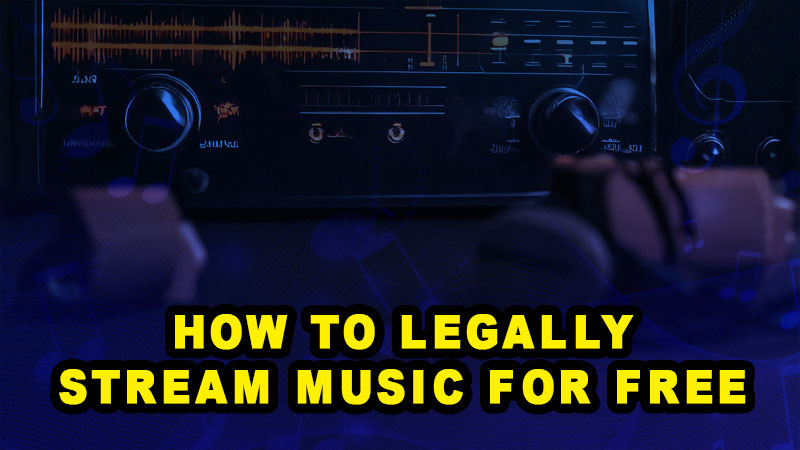Music has changed a lot over recent decades. People went from purchasing CDs and listening to the radio to streaming the world’s music on the go. Over time, the music industry shifted to accommodate these changes and gave rise to services like iTunes and Pandora. Those services, along with the others that followed, allowed anyone to access millions of songs at the tap of a finger. There are more choices than ever before, some even starting as low as $10 a month. But you don’t have to pay to get access to large music libraries.
There are also ways to stream music for free, which means you can listen to as much music as you want without spending another dime. How does music streaming work? And where can you stream legally?
How Music Streaming Works
Music streaming came from the need for companies to distribute their music legally and combat existing piracy. Now, companies have ways of earning money through licensing and royalty payments, while still keeping music relatively free. However, this meant international copyright became even more important. How exactly would companies earn their revenue with users streaming worldwide?
Most of the time, music streaming platforms acquire music through licensing agreements with record labels and independent artists. Contracts define the terms of use and royalties, whether it’s a large record label signing extensive deals for their artists or indie musicians being able to post their music on the platform. Once the music is acquired, it is uploaded and encoded for streaming, where metadata about the track or album is saved and made easily searchable.
These contracts can limit who has access to the song, including “locking” the music to a specific region so users outside the area cannot listen to it. This feature is hardly new; you can find it among several industries, including video streaming services and even gaming. For example, sites such as DraftKings and ESPN Bet can be limited in their scope by state and international laws. The main difference here, however, is that users can obtain free sweepstakes coins to play slots at online casinos if gambling is heavily restricted in their region. Music streaming platforms offer no such workaround. Platforms are often stricter in who gets access, how they obtain the files, and when they can do it.
Users who want to access a specific song or album may try their luck at finding the song they want on a different streaming platform. Each one has its own way of negotiating contracts, which means while Spotify might not have what you’re looking for, YouTube Music might. It all depends on the site’s agreement with the artist or record label.
Internet Radio
Despite what many think, the internet didn’t kill off the radio. If anything, it’s become even more accessible to people worldwide without the need for a subscription fee. Check out your local radio stations; most now stream online as well as over the air. Internet-based radio even allows you to expand your horizons with access to stations worldwide. Sites such as Radio Garden are a great way to discover new radio stations, no matter where you are. It features an interactive globe marked with local stations in most countries. Another great website is Internet Radio, which gives you access to more than 12,000 stations with different ways of sorting through them.
iHeartRadio
While this free music service falls under the internet radio category, iHeart Radio deserves its own section to explore the many features it offers. With both free and paid tiers, this is a great option for anyone looking to indulge in the nostalgia of tuning to a radio station. You can listen in on your local stations, but iHeart Radio also offers its own productions and suggestions to fill in the gaps. The combination of traditional radio, curated artist channels, and podcasts offers a little something for everyone.
SoundCloud and Bandcamp
Internet radio is a great way of tuning in locally and enjoying a particular era or genre of music. However, for those looking for more control, SoundCloud and Bandcamp are great options.
Many smaller artists will post their music for free on the sites, allowing users to discover everything from new genres to indie artists in their favorite genre. While each site has its differences, they are similar enough for listeners to be grouped.
Indie and up-and-coming artists who want their music listened to by as many people as possible use both SoundCloud and Bandcamp to maximize their reach. You might not find big-name artists such as Taylor Swift or Kendrick Lamar on there, but artists like Billie Eilish got their start on these sites. They can also organize livestreams for their supporters to tune in. Even better, you can listen on a desktop or through each site’s respective apps. And subscription deals are offered for those who want to support their favorite new artists while getting access to extra features.
YouTube Music
The rise of digital music meant record labels began finding new ways to showcase music videos and big releases. Enter YouTube. While artists have been posting their music on the platform for years now, YouTube chose to create a spinoff service called YouTube Music. In 2015, the company unveiled the new app, which would go on to replace Google Music as the default for Google users. Like other videos on the main YouTube site, music is free, though you can pay for the premium version if you don’t want ads and want access to the background play feature.
Besides the biggest hits, you can find any number of B-sides, rare plays, remixes, and more. YouTube’s autoplay feature also allows you to go down rabbit music holes. The platform will even create mixes in your recommendations, which are YouTube playlists of music (or music videos) based on your listening history. For a more curated queue, you can create your own playlists of your favorite artists and songs.
Free Tiers on Spotify, Amazon, and More
While many of these services are known for their paid options, they also offer free tiers with conditions. For example, Spotify will let you sign up for a free account, but you have to put up with ads between music and can’t download for offline listening. These types of limitations are common for services with free and premium tiers. Tidal and Amazon Music are other similar services, with the option to upgrade for access to better-quality audio, no ads, the ability to exit shuffle mode, and offline listening. While there are benefits to the paid tiers, the free one is still perfectly accessible to those who want to save some money.
Free Music for Everyone
Accessing free music has never been easier. From curated radio stations to discovering independent artists, there’s a platform that caters to every type of listener. Many offer great features without the price tag, with more made available for those who wish to support the site or artists. Mobile capabilities also make these platforms easy to tap into on long commutes or while at work. With so many options, you can enjoy music anywhere you go!





